
USS Crystal (PY-25), built in 1929 as the yacht Cambriona for Walter O. Briggs of Detroit, Michigan, was a patrol yacht in the United States Navy. The Navy acquired the yacht in January 1942 as Vida commissioning the vessel as Crystal in February. Naval service was in Hawaii until November 1945. After sale in November 1947 the vessel operated commercially in Central and South America.

USS Nokomis (SP-609) was a yacht purchased by the U.S. Navy during World War I. The yacht was purchased from Horace E. Dodge of Detroit, Michigan after he had the yacht luxuriously fitted out but before he could make use of his second Nokomis — the first having already gone into service.
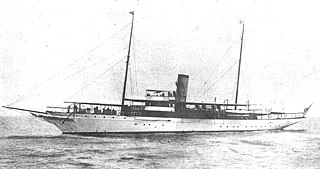
USS Lydonia (SP-700) was United States Navy patrol vessel in commission from 1917 to 1919 that saw service during World War I. Prior to her U.S. Navy service, she had been William A. Lydon's private yacht, Lydonia II, from 1912 to 1917. She spent most of the war based at Gibraltar, escorting and protecting Allied ships in the Mediterranean and along the Atlantic Ocean coast of Europe. After her U.S. Navy service ended, she served from 1919 to 1947 in the United States Coast and Geodetic Survey as the coastal survey ship USCGS Lydonia (CS-302).

USS Artemis (SP-593), launched as the steam yacht Cristina then upon sale the yacht was renamed Artemis. The yacht was purchased by the United States Navy during World War I and the name was retained. Artemis was armed with guns and depth charges and sent to Europe as a patrol craft to protect Allied ships from German submarines and other dangers. The patrol yacht was renamed Arcturus in 1918. Post-war she was returned to the United States and turned over to the United States Coast and Geodetic Survey. Later, again Artemis, the vessel was in civilian operation until burning and sinking in 1927.

USS Druid (SP-321) was a private yacht launched 10 February 1902 as Rheclair that was built for Daniel G. Reid. Reid sold the yacht to Senator Nelson W. Aldrich who renamed the yacht Nirvana only just over a year before his death. Aldrich's estate chartered Nirvana to John Wanamaker until it was bought by his son Rodman Wanamaker who used the yacht for cruising until a fire on 14 December 1916, just before a cruise south, severely damaged the vessel. He chartered an alternate vessel for his trip south and, after full repairs, the yacht was sold to Walter W. Dwyer who gave it the name Druid with intentions to sell the yacht to the government in order to finance a shipyard venture in Pensacola, Florida.

USS Margaret (SP-328) was a menhaden fishing trawler acquired by the U.S. Navy during World War I. She was configured by the Navy as a Section mine sweeper. Post-war she was sold resuming commercial fishing as Margaret. With World War II the vessel was acquired by the U.S. Coast Guard serving from December 1942 to June 1943 as an emergency manned vessel. Margaret resumed menhaden fishing and was shown as active in the U.S. register as late as 1968.
The Pusey and Jones Corporation was a major shipbuilder and industrial-equipment manufacturer. Based in Wilmington, Delaware, it operated from 1848 to 1959.

USS Zircon (PY-16) was the private yacht Nakhoda acquired by the United States Navy in 1940 serving as an armed yacht from 1941 to 1946. The yacht Nakhoda was built for automobile executive Frederick J. Fisher by Pusey and Jones Corporation, Wilmington, Delaware delivered in 1930. After the war the yacht was sold and reverted to the original name until sold in 1951 to the United New York Sandy Hook Pilots Association and renamed New York.
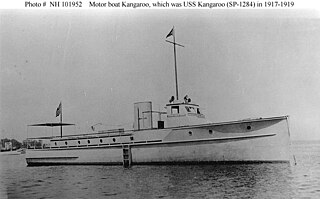
The first USS Kangaroo (SP-1284) was an armed motorboat that served in the United States Navy as a patrol vessel from 1917 to 1919.
USS Howarda (SP-144) was an armed yacht that served in the United States Navy as a patrol vessel from 1917 to 1919.

USS Apache (SP-729) was the first to be delivered of eight motor boats built by Herreshoff Manufacturing Company at Bristol, Rhode Island ordered and financed by members of the Eastern Yacht Club of Marblehead, Massachusetts. The boats were designed by Albert Loring Swasey and Nathanael Greene Herreshoff with the intention that the boats be used by the Navy as patrol craft and built with Navy approval of the design. Apache, as were the other boats, bore names under construction chosen by the owners and were then given the Section Patrol numbers on Navy acceptance and activation. The names were dropped after a period and all the boats then bore only the S.P. numbers.

The second USS Cossack (SP-695) was an armed motorboat that served in the United States Navy as a patrol vessel from 1917 to 1919.

The second USS Emerald (SP-177) was an armed yacht that served in the United States Navy as a patrol vessel from 1917 to 1918.
USS J. A. Palmer (SP-319), later USS SP-319, was a United States Navy patrol vessel in commission between 1917 and 1919. The vessel was later USCGC Pequot in U.S. Coast Guard service.

USS Legonia II (SP-399) was a United States Navy patrol vessel in commission from 1917 to 1921.
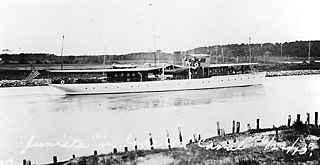
The second USS Juniata (SP-602) was a United States Navy patrol vessel in commission from 1 June 1917 to 13 July 1918. Juniata was built as the private gasoline-powered motor yacht Josephine for Edward Shearson of New York by Robert Jacobs at City Island in the Bronx, New York, in 1911. She was sold in 1914 to George W. Elkins of Philadelphia and renamed Juniata.
USS Marpessa (SP-787) was a 50 foot "express yacht" that became a United States Navy section patrol vessel in commission from 1917 to 1919 retaining the civilian name.
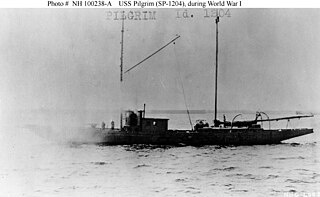
The third USS Pilgrim (SP-1204) was a United States Navy patrol vessel in commission from 1917 to 1919.

Rosinco was a diesel-powered luxury yacht that sank in Lake Michigan off the coast of Kenosha, Wisconsin in 1928. The yacht was built in 1916 as Georgiana III and served during World War I as USS Georgiana III, a Section patrol craft, under a free lease to the Navy by her owner and commanding officer. After the war the yacht was sold and renamed Whitemarsh in 1918. In 1925, after sale to Robert Hosmer Morse of Fairbanks-Morse, the yacht became Rosinco. She was sunk following a collision in 1928 and the wreck was added to the National Register of Historic Places in 2001.
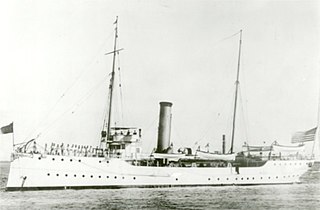
USRC Algonquin was an Algonquin-class cutter built for the U.S. Revenue Cutter Service for service on the Great Lakes. Because of the Spanish–American War, she was cut in half shortly before completion and transported to Ogdensburg, New York for service on the Atlantic coast although the war ended before she could be put into service. She was homeported at San Juan, Puerto Rico from 1905 to 1917. After the formation of the United States Coast Guard in 1915 she became USCGC Algonquin. She served as a patrol vessel at Norfolk, Virginia at the beginning of World War I before being assigned convoy duty in the Mediterranean. In February 1919 she was transferred to the West Coast and served in the Pacific Northwest and Alaska.
















